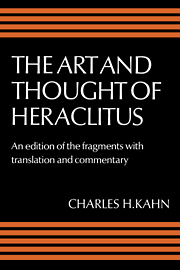 The Art and Thought of Heraclitus
The Art and Thought of Heraclitus Introductory note to text and translation
Published online by Cambridge University Press: 26 February 2010
Summary
I give here as a ‘fragment’ every ancient citation or report that seems to provide information about the content of Heraclitus' book not otherwise available. Out of these 125 fragments, only 89 qualify as fully verbatim citations, and even this figure may be a bit too generous. The other 36 texts, marked here by square brackets, form a mixed bag. They include partial quotations blended with the citer's own text, free paraphrases that may or may not preserve some of the original wording, and some reports of doctrine that do not even claim to represent Heraclitus' words. Thus this second group of texts ranges from borderline quotations, that might be counted among the literal fragments, to doctrinal statements that could be listed with the doxography (in Appendix II). At either end the division is arbitrary. More significant, and less controversial, is the difference in principle between those passages where we have Heraclitus' own words and those where we do not. It is this distinction that I have tried to mark by the use of square brackets.
The translation aims at giving a readable version of Heraclitus' text, with as much literal accuracy as is compatible with the primary goal of not making Heraclitus more obscure in English than he is in Greek. In some cases, for example in LXXIII, D. 58, this means that the translation will deviate slightly from what I print as the most plausible text. In five cases (XLII, LXXII, LXXXI, XCV, and CXIII) I have combined two paraphrases in the translation or rendered the more reliable version.
- Type
- Chapter
- Information
- The Art and Thought of HeraclitusA New Arrangement and Translation of the Fragments with Literary and Philosophical Commentary, pp. 25 - 26Publisher: Cambridge University PressPrint publication year: 1979


